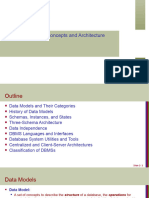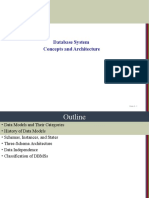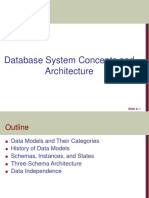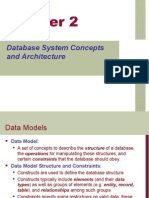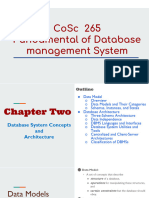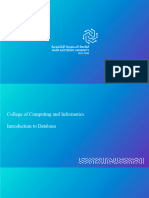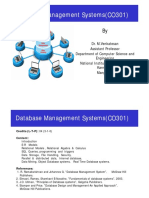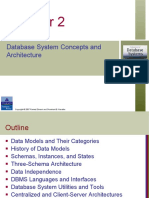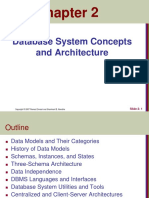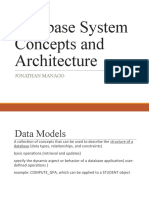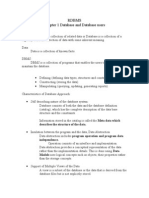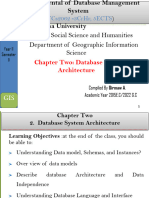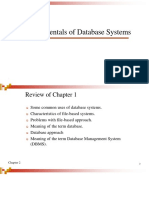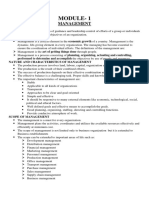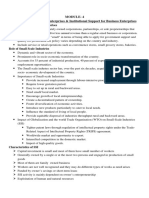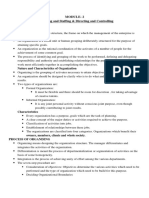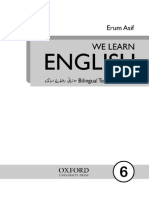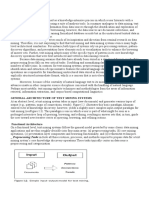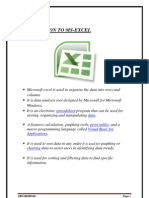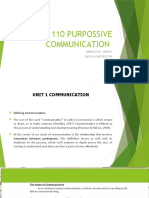Course Name: Database Management System
Course Code: 18CS53
V Semester
2018 Scheme
Module 1 – Chapter 2
�Database System
Concepts and Architecture
� Outline
Data Models and Their Categories
History of Data Models
Schemas, Instances, and States
Three-Schema Architecture
Data Independence
DBMS Languages and Interfaces
Database System Utilities and Tools
Centralized and Client-Server Architectures
Classification of DBMSs
Slide 2- 3
� Data Models
Data Model:
A set of concepts to describe the structure of a database,
the operations for manipulating these structures, and
certain constraints that the database should obey.
Data Model Structure and Constraints:
Constructs are used to define the database structure
Constructs typically include elements (and their data
types) as well as groups of elements (e.g. entity, record,
table), and relationships among such groups
Constraints specify some restrictions on valid data; these
constraints must be enforced at all times
Slide 2- 4
� Data Models (continued)
Data Model Operations:
These operations are used for specifying database
retrievals and updates by referring to the
constructs of the data model.
Operations on the data model may include basic
model operations (e.g. generic insert, delete,
update) and user-defined operations (e.g.
compute_student_gpa, update_inventory)
Slide 2- 5
� Categories of Data Models
Conceptual (high-level, semantic) data models:
Provide concepts that are close to the way many users
perceive data.
(Also called entity-based or object-based data models.)
Physical (low-level, internal) data models:
Provide concepts that describe details of how data is stored
in the computer. These are usually specified in an ad-hoc
manner through DBMS design and administration manuals
Implementation (representational) data models:
Provide concepts that fall between the above two, used by
many commercial DBMS implementations (e.g. relational
data models used in many commercial systems).
Slide 2- 6
� Schemas versus Instances
Database Schema:
The description of a database.
Includes descriptions of the database structure,
data types, and the constraints on the database.
Schema Diagram:
An illustrative display of (most aspects of) a
database schema.
Schema Construct:
A component of the schema or an object within
the schema, e.g., STUDENT, COURSE.
Slide 2- 7
� Schemas versus Instances
Database State:
The actual data stored in a database at a
particular moment in time. This includes the
collection of all the data in the database.
Also called database instance (or occurrence or
snapshot).
The term instance is also applied to individual
database components, e.g. record instance, table
instance, entity instance
Slide 2- 8
� Database Schema
vs. Database State
Database State:
Refers to the content of a database at a moment
in time.
Initial Database State:
Refers to the database state when it is initially
loaded into the system.
Valid State:
A state that satisfies the structure and constraints
of the database.
Slide 2- 9
� Database Schema
vs. Database State (continued)
Distinction
The database schema changes very infrequently.
The database state changes every time the
database is updated.
Schema is also called intension.
State is also called extension.
Slide 2- 10
�Example of a Database Schema
Slide 2- 11
�Example of a database state
Slide 2- 12
� Three-Schema Architecture
Proposed to support DBMS characteristics of:
Program-data independence.
Support of multiple views of the data.
Not explicitly used in commercial DBMS products,
but has been useful in explaining database
system organization
Slide 2- 13
� Three-Schema Architecture
Defines DBMS schemas at three levels:
Internal schema at the internal level to describe physical
storage structures and access paths (e.g indexes).
Typically uses a physical data model.
Conceptual schema at the conceptual level to describe the
structure and constraints for the whole database for a
community of users.
Uses a conceptual or an implementation data model.
External schemas at the external level to describe the
various user views.
Usually uses the same data model as the conceptual schema.
Slide 2- 14
�The three-schema architecture
Slide 2- 15
� Three-Schema Architecture
Mappings among schema levels are needed to
transform requests and data.
Programs refer to an external schema, and are
mapped by the DBMS to the internal schema for
execution.
Data extracted from the internal DBMS level is
reformatted to match the user’s external view (e.g.
formatting the results of an SQL query for display
in a Web page)
Slide 2- 16
� Data Independence
Logical Data Independence:
The capacity to change the conceptual schema
without having to change the external schemas
and their associated application programs.
Physical Data Independence:
The capacity to change the internal schema
without having to change the conceptual schema.
For example, the internal schema may be changed
when certain file structures are reorganized or new
indexes are created to improve database
performance
Slide 2- 17
� Data Independence (continued)
When a schema at a lower level is changed, only
the mappings between this schema and higher-
level schemas need to be changed in a DBMS
that fully supports data independence.
The higher-level schemas themselves are
unchanged.
Hence, the application programs need not be
changed since they refer to the external schemas.
Slide 2- 18
� DBMS Languages
Data Definition Language (DDL)
Data Manipulation Language (DML)
High-Level or Non-procedural Languages: These
include the relational language SQL
May be used in a standalone way or may be
embedded in a programming language
Low Level or Procedural Languages:
These must be embedded in a programming
language
Slide 2- 19
� DBMS Languages
Data Definition Language (DDL):
Used by the DBA and database designers to
specify the conceptual schema of a database.
In many DBMSs, the DDL is also used to define
internal and external schemas (views).
In some DBMSs, separate storage definition
language (SDL) and view definition language
(VDL) are used to define internal and external
schemas.
SDL is typically realized via DBMS commands
provided to the DBA and database designers
Slide 2- 20
� DBMS Languages
Data Manipulation Language (DML):
Used to specify database retrievals and updates
DML commands (data sublanguage) can be
embedded in a general-purpose programming
language (host language), such as COBOL, C, C+
+, or Java.
A library of functions can also be provided to access
the DBMS from a programming language
Alternatively, stand-alone DML commands can be
applied directly (called a query language).
Slide 2- 21


